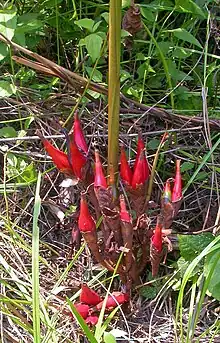Aframomum angustifolium
Aframomum angustifolium, known as "wild cardamom" in English,[2] is a species in the ginger family Zingiberaceae that grows in tropical Africa and in Madagascar.[1]
| Aframomum angustifolium | |
|---|---|
 | |
| Aframomum angustifolium fruit | |
| Scientific classification | |
| Kingdom: | Plantae |
| Clade: | Tracheophytes |
| Clade: | Angiosperms |
| Clade: | Monocots |
| Clade: | Commelinids |
| Order: | Zingiberales |
| Family: | Zingiberaceae |
| Genus: | Aframomum |
| Species: | A. angustifolium |
| Binomial name | |
| Aframomum angustifolium (Sonn.) K.Schum.[1] | |
| Synonyms[1] | |
| |
In Madagascar, it is known as longoza, due to its use as a source of energy during long hunting treks (lona "long hours", and hoza "to experience diificulties").[3] The species name, angustifolium, means "narrow-leaved" in Latin.
It is herbaceous and like other plants of this family, its erect "stems" consist of layered tubular leaf bases. The fruit is a berry containing many seeds surrounded by sugary-sweet and sour edible pulp. The crushed seeds are also used as a peppery spice.[2] The leaves are also used as disposable receptacles for eating rice.[3]
References
- "Aframomum angustifolium (Sonn.) K.Schum". Plants of the World Online. Royal Botanic Gardens, Kew. Retrieved 2020-10-03.
- Ruffo, Christopher K.; Birnie, Ann; Tengnäs, Bo (2002). Edible wild plants of Tanzania. Regional Land Management Unit/Sida. ISBN 9966-896-62-7.
- Boiteau, Pierre (1999). "longoza". Dictionnaire des noms malgaches de végétaux (in French). Vol. III. Editions Alzieu – via Malagasy Dictionary and Malagasy Encyclopedia.
This article is issued from Wikipedia. The text is licensed under Creative Commons - Attribution - Sharealike. Additional terms may apply for the media files.